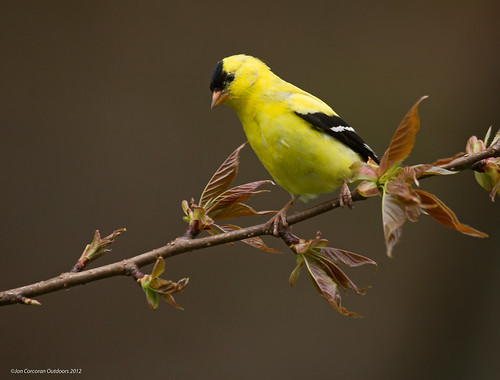American Goldfinch
(Spinus tristis)
Conservation • Description • Habitat • Ecology • Distribution • Taxonomy
|
|
|||||||||||||
Description |
|
Size |
4½″ to 5″in length 9″ wingspan |
Voice |
|
|
Similar Species |
Habitat |
Weedy fields, woodland edges, meadows. |
Ecology |
Migration |
|
Nesting |
|
Food |
|
Distribution |
Occurrence |
Common to abundant |
Maps |
The Minnesota Ornithologists’ Union All Seasons Species Occurrence Map |
Taxonomy |
|
Class |
Aves (birds) |
Order |
Passeriformes (perching birds) |
Family |
Fringillidae (finches, euphonias, and allies) |
Genus |
Haemorhous (siskins and New World goldfinches) |
American Goldfinch was originally placed in the genus Fringilla by Carl Linnaeus in 1758. It was later moved to the genus Spinus. In 1976 Spinus was merged into the genus Carduelis. Based on a molecular DNA study published in 2009 and a phylogenetic study published in 2012 American Goldfinch and 18 other Carduelis species were moved to the resurrected species Spinus. |
|
Subordinate Taxa |
|
Eastern Goldfinch (Spinus tristis tristis) Northwestern Goldfinch (Spinus tristis jewetti) Pale Goldfinch (Spinus tristis pallidus) Willow Goldfinch (Spinus tristis salicamans) |
|
Synonyms |
|
Carduelis tristis Fringilla tristis |
|
Visitor Photos |
||
Share your photo of this bird. |
||
This button not working for you? |
||
Gregory Gilman |
||
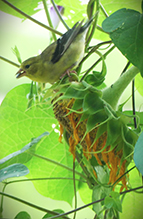 |
||
Female Goldfinch |
||
 |
 |
|
The Male Goldfinch in Winter Plumage |
||
Ramona Abrego |
||
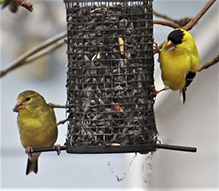 |
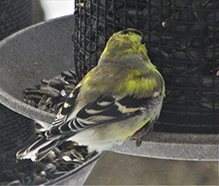 |
|
|
Spring moult |
|
Luciearl |
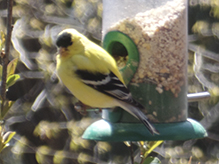 |
Alfredo Colon |
||
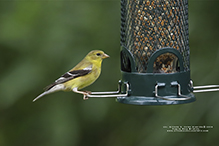 |
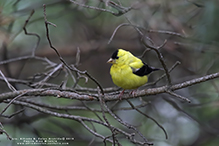 |
|
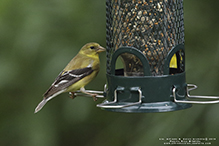 |
||
Norm & Peg Dibble |
||
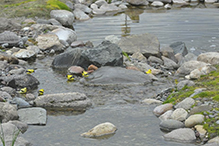 |
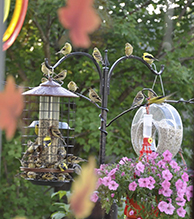 |
|
Having our shallow stream attracts many beautiful birds that want a bath. Taken through a patio glass door. |
||
|
A lot of Goldfinches at one time on two large feeders with Sunflower seed mix—a very unusual sight mid-September 2014. The blurry orange and yellow areas are fall leaf vinyl clings that were on our patio door—trying to keep birds from hitting the glass. |
|
Lynn Rubey |
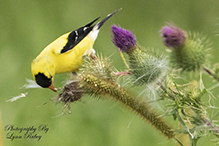 |
A breeding male American Goldfinch on the Big Stone National Wild Life Refuge on a purple thistle feeding on the thistle seeds. |
Margot Avey |
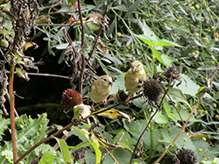 |
Tom Baker |
||
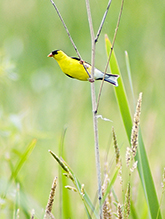 |
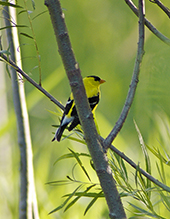 |
|
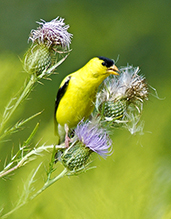 |
||
MinnesotaSeasons.com Photos |
||
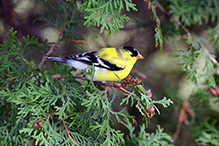 |
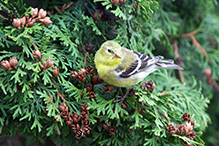 |
|
| Male | Female |
|
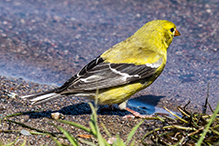 |
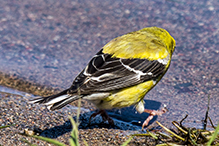 |
|
| Female | Female |

Slideshows |
American Goldfinch |
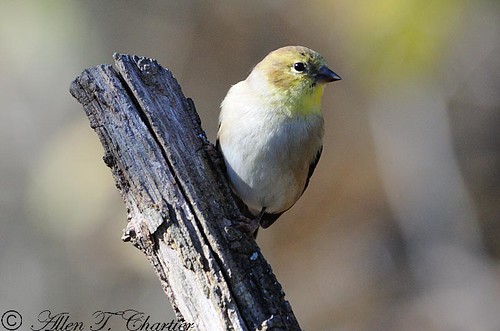
|
American Goldfinch |
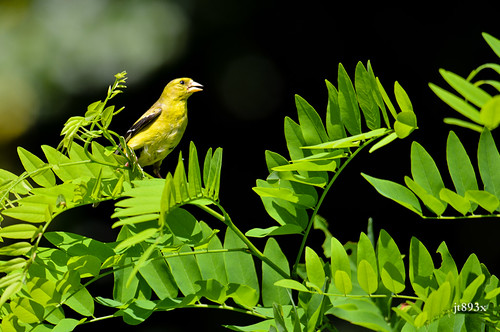
|
American Goldfinch |
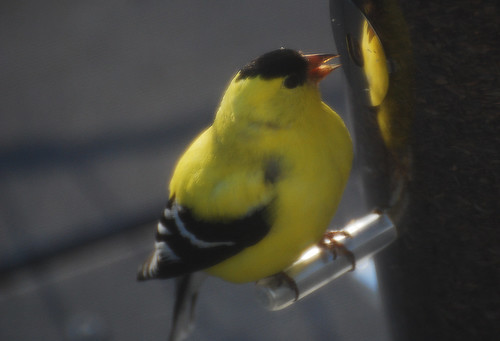
|
About
Spinus tristis |

Visitor Videos |
||
Share your video of this bird. |
||
This button not working for you? |
||
Gerry Garcia |
American Goldfinch 01 |
About
American Goldfinch (Spinus tristis) Lyndale Park, Minneapolis, MN Video by Gerry Garcia http://www.minnesotaseasons.com/Birds/American_Goldfinch.html |
Other Videos |
||
American Goldfinch (Carduelis Tristis) |
About
Published on Aug 7, 2013 American Goldfinch (Carduelis Tristis) feasting on sunflower seeds... |
American Goldfinch in HD |
About
Uploaded on Sep 7, 2009 Here are a few clips I put together of the American Goldfinch Birds that visit my feeders. They are fun to watch and have an interesting way to feed, upside down if you have the right feeder. You can get many feeding at once and these types of feeders don't attract other birds much either. I have seen a Sparrow and Black Capped Chickadee trying to feed out of these and the Chickadee was the only one that actually hung upside down briefly to get any seed. It is rarely that you see any other type of bird other than the Goldfinch at these feeders. I buy the Pennington Thistle seed for them and they love it... Here is some information on the Goldfinch I found online at Wikipedia, much more at the link below. http://en.wikipedia.org/wiki/American_goldfinch The American Goldfinch (Spinus tristis), also known as the Eastern Goldfinch and Wild Canary, is a North American bird in the finch family. It is migratory, ranging from southern Canada to North Carolina during the Breeding season, and from just south of the Canadian border to Mexico during the winter. The only finch in its subfamily which undergoes a complete molt, the American Goldfinch displays sexual dimorphism in its coloration; the male is a vibrant yellow in the summer and an olive color during the winter months, while the female is a dull yellow-brown shade which brightens only slightly during the summer. The male displays brightly colored plumage during the Breeding season to attract a mate. The American Goldfinch is a granivore and adapted for the consumption of seedheads, with a conical beak to remove the seeds and agile feet to grip the stems of seedheads while feeding. It is a social bird, and will gather in large flocks while feeding and migrating. It may behave territorially during nest construction, but this aggression is short-lived. Its Breeding season is tied to the peak of food supply, beginning in late July, which is relatively late in the year for a finch. This species is generally monogamous, and produces one brood each year. Human activity has generally benefited the American Goldfinch. It is often found in residential areas, attracted to bird feeders installed by humans, which increases its survival rate in these areas. The American Goldfinch is also the New Jersey state bird. |
American Goldfinch - HD Mini-documentary |
About
Uploaded on Oct 1, 2010 Transcript: "The American Goldfinch is found in southern Canada, the United States and parts of Mexico. It is the state bird for Iowa, New Jersey and Washington. These finches prefer to live in fields, meadows and flood plains and have adapted well to human development. They are frequent visitors to bird feeders -- especially those with Nyjer or sunflowers seeds. There agile feet are great at allowing them to hang on to weeds while their cone-like beaks are designed to eat the seeds of plants like thistle, dandelion, ragweed and alder. This small bird has a wingspan of 7-9 inches. This is a social bird that gathers in flocks. Males and females have different looks. These birds molt twice a year. In the spring, Breeding males turn bright yellow to attract females. They molt again in the winter where the plumage of both the males and females becomes a dull, yellow brown." |
American Goldfinch (Fringillidae: Spinus tristis) Foraging |
About
Uploaded on Mar 20, 2010 A flock of American Goldfinches, all in winter plumage, feeding on ground at Turtle River State Park, North Dakota. (Photographed on 20 March 2010) |
American Goldfinch |
About
Uploaded on May 13, 2011 An American Goldfinch feeding on some thistle. CAMERA : NIKON D7000 |

Visitor Sightings |
||
Report a sighting of this bird. |
||
This button not working for you? |
||
Gregory Gilman |
Location: Rochester, MN |
 |
Gregory Gilman |
Location: NW Rochester The Male Goldfinch in Winter Plumage |
 |
Gregory Gilman |
Location: NW Rochester |
 |
| Bonnie Nelson 5/4/2021 |
Location: Yellow Medicine County 3 feeding at my feeders quite lovely little birds |
|
| Ramona Abrego | Location: Forest Lake |
| Luciearl 5/10/2020 |
Location: Cass County |
| Alfredo Colon 9/28/2019 |
Location: Woodbury, Minnesota |
Gerry Garcia |
Location: Lyndale Park, Minneapolis, MN |
|
| Norm & Peg Dibble date unknown |
Location: Maple Grove, MN Having our shallow stream attracts many beautiful birds that want a bath. Taken through a patio glass door. |
| Lynn Rubey 10/5/2018 |
Location: Big Stone National Wildlife Refuge A breeding male American Goldfinch on the Big Stone National Wild Life Refuge on a purple thistle feeding on the thistle seeds. |
| Ramona Abrego 4/6/2018 |
Location: Forest Lake Spring moult |
| Margot Avey 9/28/2017 |
Location: Lake Harriet Trial Gardens, Minneapolis |
| Norm & Peg Dibble September 2014 |
Location: Maple Grove, MN A lot of Goldfinches at one time on two large feeders with Sunflower seed mix—a very unusual sight mid-September 2014. The blurry orange and yellow areas are fall leaf vinyl clings that were on our patio door—trying to keep birds from hitting the glass. |
MinnesotaSeasons.com Sightings |
||

|
Created: Last Updated: © MinnesotaSeasons.com. All rights reserved. |
